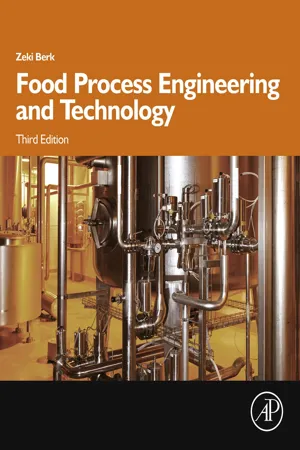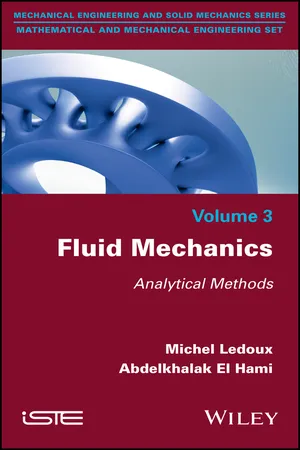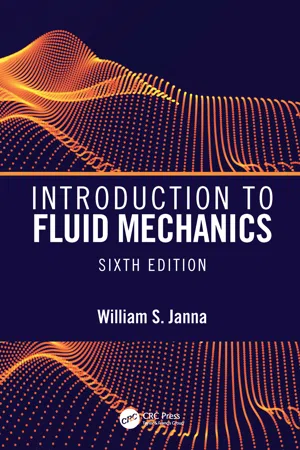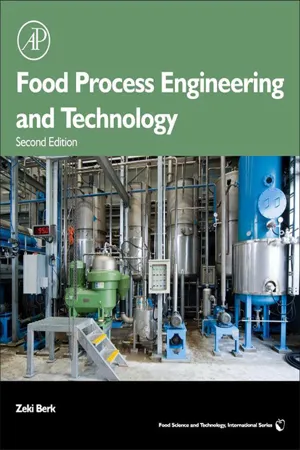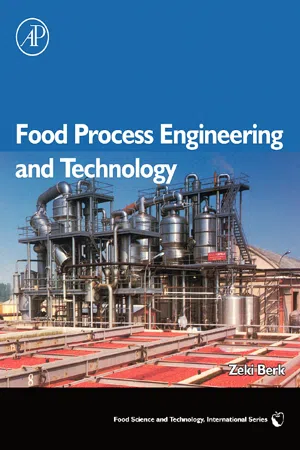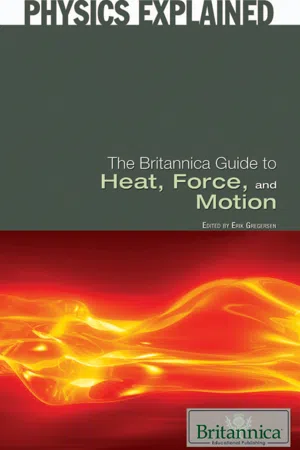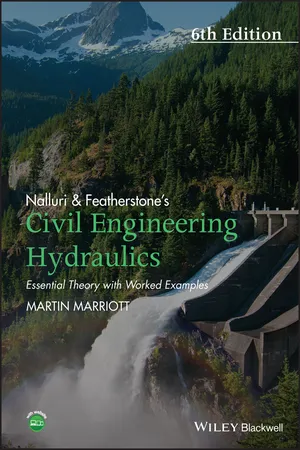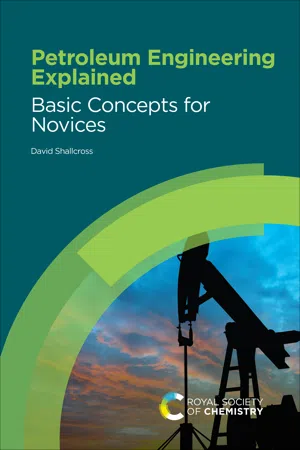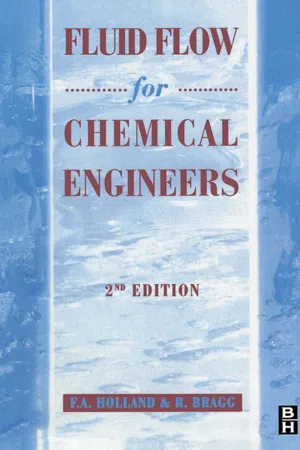Physics
Fluid Flow
Fluid flow refers to the movement of liquids or gases through a system or medium. It is characterized by the continuous deformation of the fluid, with the velocity and pressure varying at different points within the flow. Understanding fluid flow is crucial in various fields, including engineering, environmental science, and medicine, as it impacts the design and operation of systems and processes.
Written by Perlego with AI-assistance
Related key terms
11 Key excerpts on "Fluid Flow"
- O.P. Gupta(Author)
- 2022(Publication Date)
- Routledge(Publisher)
Chapter 8 Fluid Flow DOI: 10.1201/9780203756041-88.1 INTRODUCTION
Analysis of Fluid Flow encompasses an important class of problems dealing with fluid machinery, gas turbines, aerofoils, supersonic flow in space shuttles as well as silting and other phenomena associated with ports, harbours, dams, canals etc. The boundary layer associated with the flow of fluid affects other important phenomena, such as heat transfer and erosion and this forms a group of problems of its own. In addition, viscoplastic behaviour of metals has many similarities with Fluid Flow and ‘flow formulation’ has been used extensively in the analysis of situations encountered in metal forming. Modelling atmospheric wind movement in meteorology is also an interesting application.The general flow behaviour of fluids is highly non-linear and complex, involving turbulence, viscosity, volume change (compressibility) and so on. Analysis dealing with different cases of Fluid Flow has been carried out under a variety of simplifying assumptions applicable to specific cases. The fluid is taken to be inviscid and incompressible flowing under non-turbulent irrotational and steady conditions. This simplifies analysis but its applicability is thereby restricted. Complexity increases when these assumptions are dropped. Many attempts have been made to relax idealization through use of special factors and non-dimensional terms and fluid mechanics literature is replete with this heritage. Numerical techniques, especially the finite difference method, have been applied to complex cases but the situation quickly goes out of control with an increase in grid points required for more accurate results. Lately, FEM has been used with success and some hybrid methods have also been tried which make use of this method and special factors previously developed to arrive at approximate analytical solutions.- eBook - ePub
- British Gas(Author)
- 2014(Publication Date)
- Routledge(Publisher)
Flow of Fluids 4
CHAPTER 4 FLOW OF FLUIDS4.1 INTRODUCTION 4.2 TERMS AND DEFINITIONS 4.3 THE EFFECTS OF TEMPERATURE AND PRESSURE ON FLUID VOLUME 4.3.1 Liquids 4.3.2 Gases 4.4 HYDROSTATICS 4.4.1 Pressure 4.4.2 Fluid Columns 4.4.3 Buoyancy 4.5 MECHANICS OF Fluid Flow 4.5.1 Energy Balance 4.5.2 Practical Energy Balance 4.5.3 Application to Flow Measurement 4.6 FRICTION 4.6.1 Viscosity 4.6.2 Flow Regimes and Reynolds Number 4.6.3 Circular and Non-circular Sections 4.6.4 Wall Roughness 4.6.5 Coefficient of Friction 4.7 CALCULATIONS OF PRESSURE LOSSES 4.7.1 Straight Runs 4.7.2 Fittings 4.7.3 Calculation Aids REFERENCES 4.1 INTRODUCTION
Fluid Flow is of major importance to engineers. Virtually all premises, ranging from domestic dwellings to large industrial sites, have one or more Fluid Flow systems, some self-contained and others like gas and water supplied by local networks, in turn served by regional and national grids: all grist to the working engineer’s mill.The theory of Fluid Flow is formidable, covered by numerous textbooks (a selection of which is listed in the References) and continually added to as a result of R & D work. This kind of detailed specialised knowledge is of routine interest only to the fundamental designer, engaged for example in the design of a new heat exchanger or in modelling the behaviour of gases in a new type of furnace.At the practical level, the engineer is required to find answers to questions such as:— What size pipe is needed to deliver gas from the meter to the appliance at the desired pressure?— Is the steam distribution system capable of supplying a proposed additional load at its far end?— Why is the extract ventilation system not performing to specification?Traditionally, a whole range of empirical aids, rules of thumb, graphs and nomograms, flow calculators and the like is available and routinely used without recourse to basic theory, thus saving a busy engineer’s time. Whilst adequate in most cases, this simplification can be overdone and so result in under-performance, over-design, energy wastage, unnecessary cost etc. This has been partly redressed in recent years by the development of programmes for sophisticated calculators and desk-top computers, with the fundamental theory built into the software and offering the desired speed of use. - eBook - ePub
- Zeki Berk(Author)
- 2018(Publication Date)
- Academic Press(Publisher)
Essential process service media (utilities) such as water, steam, and various gases have to be distributed about the plant in properly designed pipelines. A number of important unit operations such as filtration, pressing, and mixing are, essentially, particular applications of Fluid Flow. The mechanism and rate of energy and mass transfer are strongly dependent on flow characteristics. Finally, the sensory quality of many liquid and semiliquid foods depends, to a large extent, on the flow properties of the product. This chapter consists of four parts. The first part deals with the study of fluids in motion and at rest. This is the realm of a discipline known as fluid mechanics. The second part is about the flow and deformation properties of fluids. This is the subject matter of the science called rheology. Technical elements such as pumps and piping, used for conveying fluids are discussed in the third part. The fourth part deals with flow and flow-related phenomena involving particulate solids. Techniques for the measurement and control of flow are described in Chapter 5. 2.2 Elements of Fluid Mechanics 2.2.1 Introduction Fluid mechanics is the study of fluids at rest and in motion. Fluids in motion are the subject matter of fluid dynamics or flow. Fluids are defined as substances that deform continuously under the effect of a shear stress (see below). Liquids and gases are fluids. In contrast, solids do deform when a shear stress is applied but not continuously (see Chapter 1). Fluid mechanics is a branch of physics. It deals with fluids in all possible situations, from the movement of fluids through the capillaries of a porous food to waves in the ocean and winds in the atmosphere. Although all materials, including fluids, consist of assemblies of discrete particles (e.g., molecules), fluid mechanics considers each fluid as a continuum. The average properties and behavior of the continuum and not those of the individual particles are taken into account - eBook - ePub
Fluid Mechanics
Analytical Methods
- Michel Ledoux, Abdelkhalak El Hami(Authors)
- 2017(Publication Date)
- Wiley-ISTE(Publisher)
3 A Description of Flows3.1. Introduction
The previous chapter was dedicated to immobile fluids. However, the most important aspect of fluid mechanics resides in the dynamics of these fluids; like in all branches of mechanical engineering, the movement is determined by the forces. This will be the focus of the following chapter.However, before studying the determinants of a flow, we need to acquire a tool to precisely describe the movement of this flow. This description is the subject of fluid kinetics. Therefore, in this chapter, we will not concern ourselves with finding out why a flow is. Instead, we will be concerned with better informing the reader on what it is.This chapter, which is dedicated to the description of a flow, will also be an opportunity to present the “first of the two physics principles” of fluid mechanics.When writing “the two physics principles”, we need to be aware of what we are arbitrarily limiting to dynamics. Placed where it should be within the realm of thermodynamics, “extended” fluid mechanics should integrate various other equations. In the first place, the energy equation is the expression adapted from the first principle of thermodynamics. While fluid is a mixture, it should also not be written as a diffusion equation by species. There are many types of transport present in the systems: viscosity, thermal conduction, possibly radiation and diffusion.This work is dedicated to the first order of dynamics studies. Nevertheless, we will have to introduce the energy equation further on, which is dedicated to compressible fluids. This chapter compiles: a) At the tooling stage, the method for describing a flow. We will see that the method adopted differs from that which is familiar to the reader and used in mechanics of point power.b) At the physics stage, how to write and apply the first physics principle, the principle of continuity. This principle, which is attached to the continuous nature of the matter implied, in fact expresses the conservation of matter. It is not necessary to express this principle with material elements, which are conserved because identified. In a continuous domain of fluid, the parts are not identified a priori - eBook - ePub
- William S. Janna(Author)
- 2020(Publication Date)
- CRC Press(Publisher)
3 Basic Equations of Fluid MechanicsBefore we begin a discussion of the equations of fluid mechanics, it is important to examine types of flows and how they can be characterized. Closed-conduit flows are completely enclosed by restraining solid surfaces; examples are flow through a pipe and flow between parallel plates where there is no free surface. Open-channel flows have one surface exposed to atmospheric pressure; examples are flow in a river and flow in a spillway. In unbounded flows , the fluid is not in contact with any solid surface; examples are the jet that issues from a household faucet and the jet from a can of spray paint.After completing this chapter, you should be able to:- Discuss the behavior of flowing fluids in various situations;
- Recognize the unified mathematical approach to solving Fluid Flow problems;
- Derive the equations of fluid mechanics;
- Apply the continuity, momentum, energy and Bernoulli equations to problems.
3.1 KINEMATICS OF FLOW
In flow situations, solution of a problem often requires determination of a velocity. As we will see, however, velocity varies in the flow field. Moreover, the flow can be classified according to how the velocity varies. If the parameters of both the fluid and the flow are constant at any cross section normal to the flow, or if they are represented by average values over the cross section, the flow is said to be one-dimensional . Velocity distributions for one-dimensional flow are illustrated in Figure 3.1 . Although flow velocity may change from point to point, it is constant at each location.FIGURE 3.1 One-dimensional flow where velocity and pressure are uniform at any cross section.A flow is said to be two-dimensional if the fluid or the flow parameters have gradients in two directions. In Figure 3.2 a—flow in a pipe—the velocity at any cross section is parabolic. The velocity is thus a function of the radial coordinate; a gradient exists. In addition, a pressure gradient exists in the axial direction that maintains the flow. That is, a pressure difference from inlet to outlet is imposed on the fluid that causes flow to occur. The flow is one-directional, but because we have both a velocity and a pressure gradient, it is two-dimensional. Another example of two-dimensional flow is given in Figure 3.2 b. At the constant-area sections, the velocity is a function of one variable. At the convergent section, velocity is a function of two space variables. In addition, a pressure gradient exists that maintains the flow. Figure 3.2 - eBook - ePub
- Zeki Berk(Author)
- 2013(Publication Date)
- Academic Press(Publisher)
Chapter 2Fluid Flow
2.1 Introduction
The majority of industrial food processes involve fluid movement. Liquid foods such as milk and juices have to be pumped through processing equipment or from one container to another. In a blast freezer, a rapid stream of cold air is blown over the food. In a wheat mill, the grain, the milled intermediates and the final products are most often conveyed in a stream of air (pneumatic conveying). Essential process service media (utilities) such as water, steam and various gases have to be distributed about the plant in properly designed pipelines. A number of important unit operations, such as filtration, pressing and mixing, are, essentially, particular applications of Fluid Flow. The mechanism and rate of energy and mass transfer are strongly dependent on flow characteristics. Finally, the sensory quality of many liquid and semi-liquid foods depends, to a large extent, on the flow properties of the product.This chapter consists of four parts. The first part deals with the study of fluids in motion. This is the realm of a discipline known as fluid mechanics . The second part is about the flow and deformation properties of fluids. This is the subject matter of the science called rheology. Technical elements such as pumps and piping used for conveying fluids are discussed in the third part. The fourth part deals with flow and flow-related phenomena involving particulate solids . Techniques for the measurement and control of flow are described in Chapter 5 .2.2 Elements of fluid mechanics
2.2.1 Viscosity
Consider a mass of fluid confined between two flat plates (Figure 2.1 ). The lower plate is held stationary, and the upper plate moves in the x direction at a constant velocity vx . Assume that the liquid layer in immediate contact with each plate moves at the velocity of that plate (no slippage). What has been described is clearly a shearing - eBook - ePub
- Zeki Berk(Author)
- 2008(Publication Date)
- Academic Press(Publisher)
Chapter 2. Fluid Flow
2.1. Introduction
The majority of industrial food processes involve fluid movement. Liquid foods such as milk and juices have to be pumped through processing equipment or from one container to another. In a blast freezer, a rapid stream of cold air is blown over the food. In a wheat mill, the grain, the milled intermediates and the final products are most often conveyed in a stream of air (pneumatic conveying). Essential process service media (utilities) such as water, steam and various gases have to be distributed about the plant in properly designed pipelines. A number of important unit operations such as filtration, pressing and mixing are, essentially, particular applications of Fluid Flow. The mechanism and rate of energy and mass transfer are strongly dependent on flow characteristics. Finally, the sensory quality of many liquid and semi-liquid foods depends, to a large extent, on the flow properties of the product.This chapter consists of four parts. The first part deals with the study of fluids in motion. This is the realm of a discipline known as ‘fluid dynamics’. The second part is about the flow and deformation properties of fluids. This is the subject matter of the science called ‘rheology’. Technical elements such as pumps and piping, used for conveying fluids are discussed in the third part. The fourth part deals with flow and flow-related phenomena involving particulate solids. Techniques for the measurement and control of flow are described in Chapter 5 .2.2. Elements of Fluid Dynamics
2.2.1. Viscosity
Consider a mass of fluid confined between two flat plates (Figure 2.1 ). The lower plate is held stationary. The upper plate moves in the x direction at a constant velocity vx - eBook - ePub
- Britannica Educational Publishing, Erik Gregersen(Authors)
- 2010(Publication Date)
- Britannica Educational Publishing(Publisher)
CHAPTER 9 LIQUIDS IN MOTIONT his chapter deals with fluids that are in motion in a steady fashion such that the fluid velocity at each given point in space is not changing with time. Any flow pattern that is steady in this sense may be seen in terms of a set of streamlines, the trajectories of imaginary particles suspended in the fluid and carried along with it. In steady flow, the fluid is in motion but the streamlines are fixed. Where the streamlines crowd together, the fluid velocity is relatively high; where they open out, the fluid becomes relatively stagnant.BERNOULLI’S LAW
When Euler and Bernoulli were laying the foundations of hydrodynamics, they treated the fluid as an idealized inviscid substance in which, as in a fluid at rest in equilibrium, the shear stresses associated with viscosity are zero and the pressure p is isotropic. They arrived at a simple law relating the variation of p along a streamline to the variation of υ (the principle is credited to Bernoulli, but Euler seems to have arrived at it first), which serves to explain many of the phenomena that real fluids in steady motion display. To the inevitable question of when and why it is justifiable to neglect viscosity, there is no single answer.Consider a small element of fluid of mass m , which—apart from the force on it due to gravity—is acted on only by a pressure p . The latter is isotropic and does not vary with time but may vary from point to point in space. It is a well-known consequence of Newton’s laws of motion that, when a particle of mass m moves under the influence of its weight mg and an additional force F from a point P where its speed is υ P and its height is z P to a point Q where its speed is υ Q and its height is z Q - eBook - ePub
Nalluri And Featherstone's Civil Engineering Hydraulics
Essential Theory with Worked Examples
- Martin Marriott(Author)
- 2016(Publication Date)
- Wiley-Blackwell(Publisher)
In laminar flow, the fluid particles move along smooth layers, one layer gliding over an adjacent layer. Viscous shear stresses dominate in this kind of flow in which the shear stress and velocity distribution are governed by Newton’s law of viscosity (Equation 1.1). In turbulent flows, which occur most commonly in engineering practice, the fluid particles move in erratic paths causing instantaneous fluctuations in the velocity components. These turbulent fluctuations cause an exchange of momentum setting up additional shear stresses of large magnitudes. An equation of the form similar to Newton’s law of viscosity (Equation 1.1) may be written for turbulent flow by replacing μ by η. The coefficient η, called the eddy viscosity, depends on the fluid motion and the density. Figure 3.4 Streamline patterns and types of acceleration: (a) no accelerations exist; (b) tangential convective accelerations; (c) normal convective accelerations; and (d) tangential and normal convective accelerations. The type of a flow is identified by the Reynolds number, Re = ρ VL/μ, where ρ and μ are the density and viscosity of the fluid, V is the flow velocity and L is a characteristic length such as the pipe diameter (D) in the case of a pipe flow. Reynolds number represents the ratio of inertial forces to the viscous forces that exist in the flow field and is dimensionless. The flow through a pipe is always laminar if the corresponding Reynolds number (Re = ρ VD/μ) is less than 2000, and for all practical purposes the flow may be assumed to pass through a transition to full turbulent flow in the range of Reynolds numbers from 2000 to 4000. 3.9 Dynamics of Fluid Flow The study of fluid dynamics deals with the forces responsible for fluid motion and the resulting accelerations. A fluid in motion experiences, in addition to gravity, pressure forces, viscous and turbulent shear resistances, boundary resistance and forces due to surface tension and compressibility effects of the fluid - eBook - ePub
Petroleum Engineering Explained
Basic Concepts for Novices
- David Shallcross(Author)
- 2020(Publication Date)
- Royal Society of Chemistry(Publisher)
All fluids including oil, natural gas and water, will flow through a pipe from a region of high pressure to a region of low pressure. It is the pressure difference that drives the flow. The rate at which the fluid will flow along the pipe will depend upon a range of factors including the pipe diameter, the surface roughness of the pipe's internal walls, and the fluid properties including the density and viscosity. In this section we will apply a relationship known as Bernoulli's equation to calculate the flow of liquids through pipes.We begin by considering flow through a section of pipe as shown in Figure 7.5 . To make our discussion as general as possible, let's allow the diameter of the pipe to vary between the entry point, point ① and the exit point, point ②. We will declare that the fluid enters the pipe section at ① with an average velocity of u 1 and with a density of ρ 1 . The cross-sectional area of the pipe at ① is A 1 . The fluid passes point ② with an average velocity of u 2 , and density ρ 2 , through a cross-sectional area of A 2 .Figure 7.5Fluid enters at point ① with an average velocity, u 1 , and density ρ 1 , through a pipe of cross-sectional area A 1 . It leaves point ② flowing at u 2 with density ρ 2 through area A 2 .Providing that mass does not accumulate within the section of pipe, the mass flow rate of the fluid entering the pipe must equal the mass flow rate of fluid leaving the section, so,7.9 ṁ 1 = ṁ 2where, ṁ 1 is the mass flow rate of the fluid at point ①. We know that density is the mass of a material divided by the volume it occupies:7.10Here, ρ is the density of the fluid, and V is the volume occupied by the mass m . Re-arranging this equation we can write:7.11 m = ρ VSo, we can now express the mass balance equation of (7.9) as:7.12 ρ 1 V̇ 1 = ρ 2 V̇ 2Here, V̇ 1 and V̇ 2 are the fluid's volumetric flow rates at points ① and ②. The volumetric flow rate of the fluid may be found if the average fluid velocity, u , and the cross-sectional area are known:7.13 V̇ = u ASubstituting this relationship into eqn (7.12) allows us to write,7.14 ρ 1 u 1 A 1 = ρ 2 u 2 A 2Fluids may be classified either as being compressible or incompressible, depending upon whether their density changes during flow. Except at extremely high pressures, liquids may generally be considered to be incompressible. The density of a Fluid Flowing in a pipe will not change with pressure, although it might still change with temperature. Gas densities vary significantly with both temperature and pressure, so flowing gases are classified as being in compressible flow. - eBook - ePub
- F. Holland, R. Bragg(Authors)
- 1995(Publication Date)
- Butterworth-Heinemann(Publisher)
equation 1.14 ).Example 1.5
A Newtonian liquid in laminar flow in a horizontal tube emerges into the air as a jet from the end of the tube. What is the relationship between the diameters of the jet and the tube?Calculations: It is assumed that the Reynolds number is sufficiently high for the fluid’s momentum to be dominant and consequently the momentum flow rate in the jet will be the same as that in the tube. On emerging from the tube, there is no wall to maintain the liquid’s parabolic velocity profile and consequently the jet develops a uniform velocity profile.Equating the momentum of the liquid in the tube to that in the jet giveswhere u 1 , u 2 are the volumetric average velocities in the tube and jet respectively andTherefore orri , rjthe radii of the tube and the jet. By continuity:Thus, the jet must have a smaller diameter than the tube in order for momentum to be conserved. This result is valid when the liquid’s momentum is dominant. At very low Reynolds numbers, viscous stresses are dominant and the velocity profile starts to change even before the exit plane: in this case the jet diameter is slightly larger than the tube diameter.1.6.2 Total force due to flow
In the preceding examples, cases in which there is a change in the momentum of a flowing fluid have been considered and the reactions on the pipe-work due solely to changes of fluid momentum have been determined. Sometimes it is required to make calculations of all forces acting on a piece of equipment as a result of the presence of the fluid and its flow through the equipment; this is illustrated in Example 1.6 .Example 1.6
Figure 1.9 illustrates a nozzle at the end of a hose-pipe. It is convenient to align the x -coordinate axis along the axis of the nozzle. The y -axis is perpendicular to the x -axis as shown and the x–y
Index pages curate the most relevant extracts from our library of academic textbooks. They’ve been created using an in-house natural language model (NLM), each adding context and meaning to key research topics.


